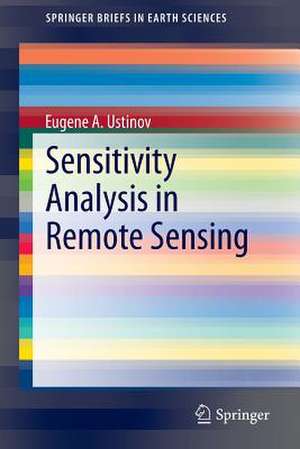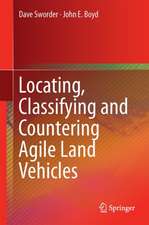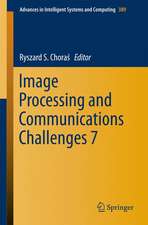Sensitivity Analysis in Remote Sensing: SpringerBriefs in Earth Sciences
Autor Eugene A. Ustinoven Limba Engleză Paperback – 14 apr 2015
Sensitivity analysis (SA) serves for quantitative models of physical objects the same purpose, as differential calculus does for functions. SA provides derivatives of model output parameters (observables) with respect to input parameters. In remote sensing SA provides computer-efficient means to compute the jacobians, matrices of partial derivatives of observables with respect to the geophysical parameters of interest. The jacobians areused to solve corresponding inverse problems of remote sensing. They also play an important role already while designing the remote sensing experiment, where they are used to estimate the retrieval uncertainties of the geophysical parameters with given measurement errors of the instrument, thus providing means for formulations of corresponding requirements to the specific remote sensing instrument.
If the quantitative models of geophysical objects can be formulated in an analytic form, then sensitivity analysis is reduced to differential calculus. But in most cases, the practical geophysical models used in remote sensing are based on numerical solutions of forward problems – differential equations with initial and/or boundary conditions. As a result, these models cannot be formulated in an analytic form and this is where the methods of SA become indispensable.
This book is intended for a wide audience. The beginners in remote sensing could use it as a single source, covering key issues of SA, from general principles, through formulation of corresponding linearized and adjoint problems, to practical applications to uncertainty analysis and inverse problems in remote sensing. The experts, already active in the field, may find useful the alternative formulations of some key issues of SA, for example, use of individual observables, instead of a widespread use of the cumulative cost function. The book also contains an overview of author’s matrix operator approach to formulation of adjoint problems for forward problems based on the higher-order partial differential equations. This approach still awaits its publication in the periodic literature and thus may be of interest to readership across all levels of expertise.
Din seria SpringerBriefs in Earth Sciences
-
 Preț: 380.25 lei
Preț: 380.25 lei -
 Preț: 378.12 lei
Preț: 378.12 lei -
 Preț: 290.09 lei
Preț: 290.09 lei -
 Preț: 477.72 lei
Preț: 477.72 lei -
 Preț: 381.98 lei
Preț: 381.98 lei -
 Preț: 355.07 lei
Preț: 355.07 lei -
 Preț: 355.37 lei
Preț: 355.37 lei -
 Preț: 351.90 lei
Preț: 351.90 lei -
 Preț: 381.21 lei
Preț: 381.21 lei -
 Preț: 377.35 lei
Preț: 377.35 lei -
 Preț: 342.44 lei
Preț: 342.44 lei -
 Preț: 343.98 lei
Preț: 343.98 lei - 20%
 Preț: 389.08 lei
Preț: 389.08 lei -
 Preț: 378.92 lei
Preț: 378.92 lei -
 Preț: 375.62 lei
Preț: 375.62 lei -
 Preț: 379.68 lei
Preț: 379.68 lei -
 Preț: 378.12 lei
Preț: 378.12 lei -
 Preț: 377.18 lei
Preț: 377.18 lei -
 Preț: 443.75 lei
Preț: 443.75 lei -
 Preț: 378.54 lei
Preț: 378.54 lei -
 Preț: 380.07 lei
Preț: 380.07 lei -
 Preț: 376.96 lei
Preț: 376.96 lei -
 Preț: 379.09 lei
Preț: 379.09 lei - 15%
 Preț: 464.18 lei
Preț: 464.18 lei -
 Preț: 376.96 lei
Preț: 376.96 lei -
 Preț: 348.01 lei
Preț: 348.01 lei -
 Preț: 375.07 lei
Preț: 375.07 lei -
 Preț: 477.94 lei
Preț: 477.94 lei -
 Preț: 376.22 lei
Preț: 376.22 lei -
 Preț: 349.41 lei
Preț: 349.41 lei -
 Preț: 381.00 lei
Preț: 381.00 lei - 15%
 Preț: 463.35 lei
Preț: 463.35 lei -
 Preț: 376.22 lei
Preț: 376.22 lei -
 Preț: 376.96 lei
Preț: 376.96 lei -
 Preț: 446.47 lei
Preț: 446.47 lei -
 Preț: 346.62 lei
Preț: 346.62 lei -
 Preț: 379.68 lei
Preț: 379.68 lei -
 Preț: 373.32 lei
Preț: 373.32 lei -
 Preț: 377.95 lei
Preț: 377.95 lei -
 Preț: 377.57 lei
Preț: 377.57 lei -
 Preț: 390.83 lei
Preț: 390.83 lei -
 Preț: 375.45 lei
Preț: 375.45 lei -
 Preț: 377.73 lei
Preț: 377.73 lei -
 Preț: 376.04 lei
Preț: 376.04 lei -
 Preț: 377.18 lei
Preț: 377.18 lei -
 Preț: 379.09 lei
Preț: 379.09 lei
Preț: 379.48 lei
Nou
Puncte Express: 569
Preț estimativ în valută:
72.62€ • 77.65$ • 60.54£
72.62€ • 77.65$ • 60.54£
Carte tipărită la comandă
Livrare economică 18 aprilie-02 mai
Preluare comenzi: 021 569.72.76
Specificații
ISBN-13: 9783319158402
ISBN-10: 3319158406
Pagini: 128
Ilustrații: XIII, 128 p. 2 illus.
Dimensiuni: 155 x 235 x 12 mm
Greutate: 0.21 kg
Ediția:2015
Editura: Springer International Publishing
Colecția Springer
Seria SpringerBriefs in Earth Sciences
Locul publicării:Cham, Switzerland
ISBN-10: 3319158406
Pagini: 128
Ilustrații: XIII, 128 p. 2 illus.
Dimensiuni: 155 x 235 x 12 mm
Greutate: 0.21 kg
Ediția:2015
Editura: Springer International Publishing
Colecția Springer
Seria SpringerBriefs in Earth Sciences
Locul publicării:Cham, Switzerland
Public țintă
ResearchCuprins
1. Introduction: Remote Sensing and Sensitivity Analysis.- 2. Sensitivity Analysis: Differential Calculus of Models.- 3. Three Approaches to Sensitivity Analysis of Models.- 4. Sensitivity Analysis of Analytic Models: Applications of Differential and Variational Calculus.- 5. Sensitivity Analysis of Analytic Models: Linearization and Adjoint Approaches.- 6. Sensitivity Analysis of Numerical Models.- 7. Sensitivity Analysis of Models with higher-Order Differential Equations.- 8. Applications of Sensitivity Analysis in Remote Sensing.- Appendix Operations with matrices and vectors.- Index.
Recenzii
“This book will be of great interest to a wide rangeof researchers specializing in inverse problems. It provides a new perspectivefor understanding the fundamental relations between sensitivity analysis andinverse problems. It also can be useful for beginners who wish to learn aboutthe key issues of sensitivity analysis, the formulations of the correspondinglinearized and adjoint problems, and practical applications of inverse problemsin remote sensing.” (Natesan Barani Balan, Mathematical Reviews, December, 2015)
Caracteristici
Includes supplementary material: sn.pub/extras



















